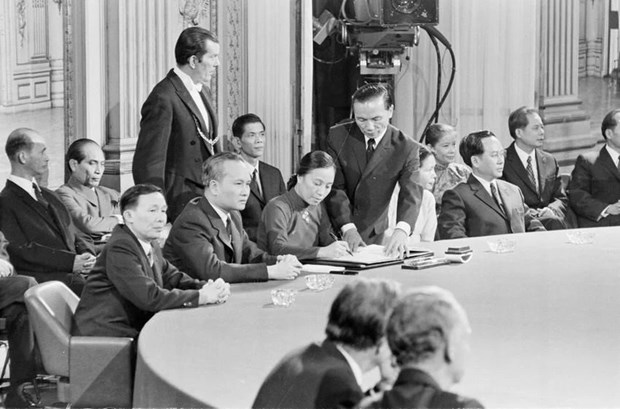 Society
Society

 |
| Nguyễn Thị Bình, Foreign Minister of the Provisional Revolutionary Government of the Republic of South Vietnam, signs the Paris Peace Accords at the international convention centre in Paris, France, on January 27, 1973. — VNA/VNS Photo |
QUẢNG TRỊ – Fifty-one years since the signing of the Paris Peace Accords, the central province of Quảng Trị, once the frontline between the north and the south of Việt Nam, has been taking strong steps forward and cherishing the values of peace.
The Trị - Thiên Campaign to liberate Quảng Trị in 1972 and the struggle that lasted for 81 days and nights, from June 28 to September 16, 1972, to defend Quảng Trị Ancient Citadel are among the many fights and places going down in the great national safeguarding history.
After being defeated in the 1972 Trị - Thiên Campaign, the US and its puppet administration plotted to re-occupy Quảng Trị Ancient Citadel to gain advantage in the negotiations at the Paris conference. Meanwhile, the Vietnamese army and people stayed resolute to defend this citadel to add to victories on other battlefields to force the US imperialists to sign the Paris Agreement on Ending the War and Restoring Peace in Việt Nam.
Together with the fierce fight to protect Quảng Trị Ancient Citadel in 1972, the Vietnamese army and people’s defeat of the US’ unprecedented strategic bombings in December the same year, the “Hà Nội – Điện Biên Phủ in the air” victory, forced the US to sign the Paris Peace Accords on January 27, 1973.
Prof. Dr. Trình Quang Phù, Director of the Oriental Research Development Institute under the Vietnam Union of Science and Technology Associations, said the Paris Peace Accords came as a result of the Vietnamese army and people’s struggles on battlefields and the excellent military - diplomacy combination. The successful safeguarding of Quảng Trị Ancient Citadel during the 81 days and nights helped force the enemy to sit down at the negotiating table to ink the Paris Agreement on Ending the War and Restoring Peace in Việt Nam.
More than half a century has passed, and the former battlefield of Quảng Trị is now covered with rice paddy fields, industrial tree plantations and forests. Residential areas, big roads and modern sea and air ports are built in areas once witnessing ferocious fights over 50 years ago. Local residents also enjoy a better quality of life, with per capita income averaging VNĐ71 million (nearly US$2,900) in 2023.
Tourists now come to Quảng Trị to learn about, feel and understand the pains of war and division, which nothing can compensate for, that the nation suffered in the past. Here, they can thoroughly grasp the passion for living, independence, freedom, and reunification of a nation that has grappled with challenges and wars waged by the most powerful invaders throughout history, to become fully aware of the values of peace and development.
Nguyễn Huy Hùng, Deputy Director of the provincial Department of Culture, Sports and Tourism, said Quảng Trị is home to 501 historical and cultural relic sites, many of which are renowned among domestic and international visitors thanks to their historical significance. Such special national relic sites as Quảng Trị Ancient Citadel, Hiền Lương Bridge and the Bến Hải River, Vĩnh Mốc Tunnels, the tunnel village of Vĩnh Linh, the Trường Sơn national martyrs’ cemetery, and the Road 9 national martyrs’ cemetery make up the unique system of local war relic sites.
Quảng Trị could be considered the most vivid museum of revolutionary war relics, he said, noting that this is a basis for developing cultural and historical tourism.
The provincial administration is set to organise the first Festival for Peace in July 2024 to honour the values of peace and call on all people to join hands in maintaining and building a life of peace, prosperity and sustainability for Quảng Trị, Việt Nam, and humankind.
It will pay tribute to the heroes and soldiers who laid down their lives for the immortality of the Fatherland, while commemorating war victims as well as war losses and pains. It will also introduce tangible and intangible cultural values along with tourism products of Quảng Trị to help attract domestic and international visitors, thus contributing to local socio-economic development. — VNS